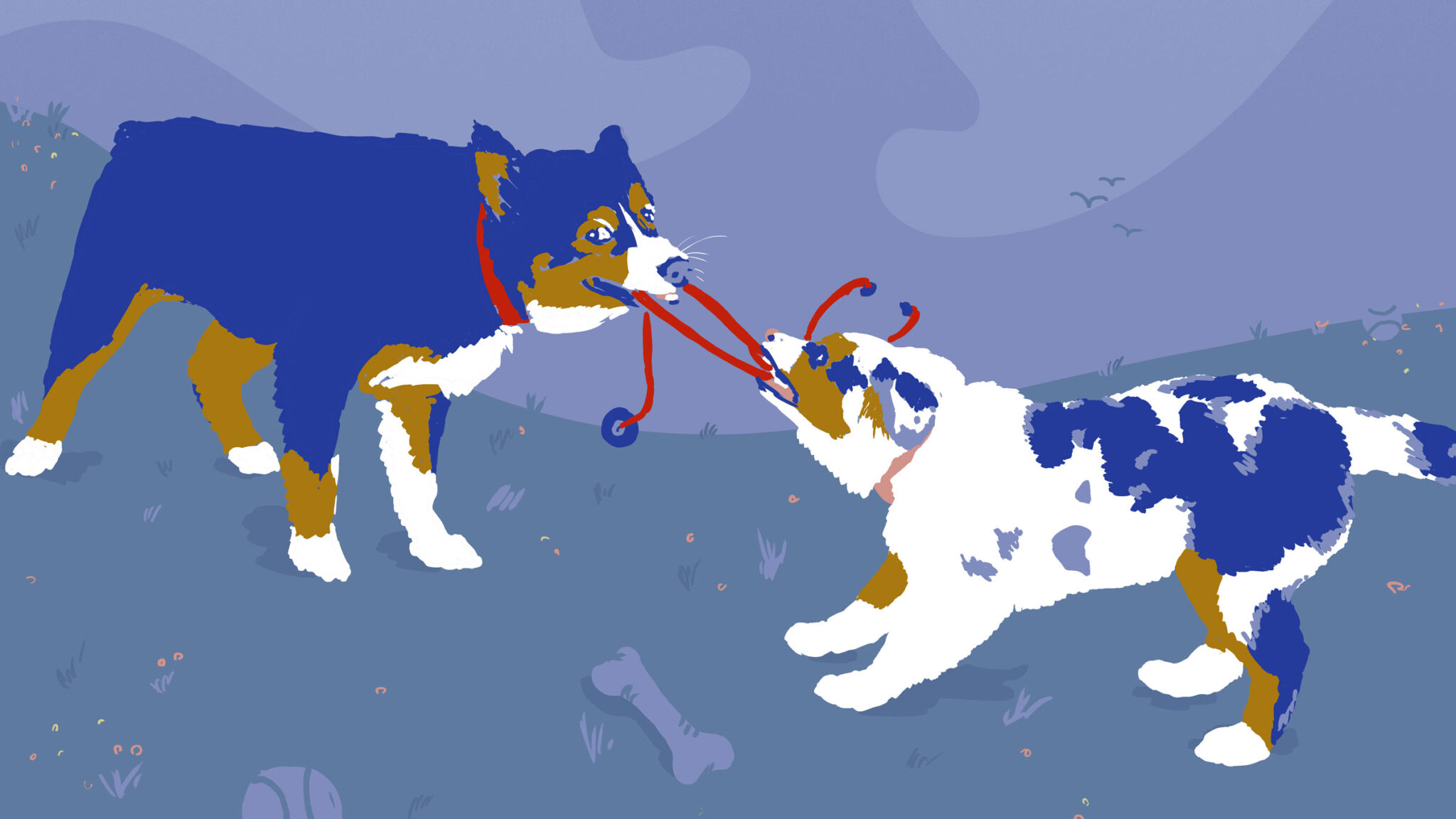It appears that researchers needn’t venture far from home in search of animals that experience cancer much like we humans do.
Increasingly, to enrich understanding of cancer biology and to test therapies, science is focusing on pet dogs.
Considered by many comparative oncologists to be a bridge between mouse models and human clinical trials, pet dogs are studied to supplement the traditional bench-to-bedside research model. On top of that, canine clinical trials do not face the same challenges that human trials do.
Over her 28-year career, Elaine Ostrander, head of the National Human Genome Research Institute’s Dog Genome Project at NIH and a comparative genomic researcher, has witnessed the scientific community’s stance toward comparative oncology—and pet dog studies—shift from apprehension to enthusiasm.
“I’ve really been able to watch this field grow from people saying, ‘Why would you ever sequence a dog genome?’ to my lab sequencing hundreds,” Ostrander, who is also chief and distinguished senior investigator of the Cancer Genetics and Comparative Genomics Branch at the National Human Genome Research Institute of NIH and head of the Section of Comparative Genetics, said to The Cancer Letter.
Money has followed interest:
- In 2016, NCI added administrative supplements to the P30 Cancer Center Support Grants for research in canine immunotherapy through the collaboration of NCI-Designated Cancer Centers and veterinary medical colleges
- In 2017 and 2022, NCI funded two rounds of PRECINCT awards to support canine immunotherapy clinical trials
- In 2020, NCI established the Integrated Canine Data Commons, a nearly $5.5 million investment, which makes an ever-growing data repository of canine cancer data publicly available
- Most recently, in May 2022, Jaguar Health Canine Cancer established the Take C.H.A.R.G.E (Canine Health and ReGistry Exchange) Registry, a first-of-its-kind canine cancer database that helps track the incidence and prevalence of canine cancer to help both dogs and humans.
What dog studies can do
Dog cancers are more representative of human disease than mouse tumors, and cancer in dogs arise spontaneously, like it does in humans.
Mouse models, by contrast, usually need to be “given” cancer—it doesn’t arise naturally—and often the immune system of lab mice is suppressed to enhance growth of the implanted cancer.
“In mice, we are injecting the cancer or we’re directly manipulating the genes, and that’s not how it happens in people,” Robert Canter, a surgical oncologist at University of California Davis Comprehensive Cancer Center who leads canine immunotherapy trials, said to The Cancer Letter. “We’re not giving these dogs cancer in any way. Their cancer develops as part of a disease situation, just like cancer develops in people—genetic mutations, exposures, the increasing mutations over time, and so forth.”
This is important, particularly for immunotherapy research, Canter said.


“The cancer develops in the setting of an intact immune system. So, for the cancer to really grow and take off, it has to evade the immune system. And since we’re trying to find a way to kind of turn the immune system back on, or overcome those suppressive mechanisms, it really is the best replica of how that process takes place,” Canter said. “So, the genetics are the same, the epigenetics, the relationship to the immune system, the microbiome. All those things that we’ve learned are so important in human cancer are very closely replicated in dog cancer.
“Comparative oncology really is a fantastic resource for that, because of the complex interaction between cancer and the immune system and the rest of the host. You’re never going to get that with a mouse.”
The spontaneity of dog cancers can be particularly informative since dogs share environments with their human owners, Ostrander said.
“They live in our world. They eat our crappy food, they’re exposed to our fertilizer, our bad water, our pollution, whatever the environmental factors are that have been associated with prostate cancer—and there’s a lot,” Ostrander said. “Dogs have all those exposures too.”
Enrollment in clinical trials often happens much faster for dog studies than for human trials. This, in combination with the shorter canine lifespan, means that results are available much more quickly.
“It’s not just understanding safety. Particularly with these immunotherapies, we need to understand how to use them,” Nicola Mason, lead of the PRE-medical Cancer Immunotherapy Network Canine Trials, or PRECINCT, coordinating center at University of Pennsylvania, said to The Cancer Letter. “We need to understand: Should they be combined with surgery or radiation therapy or a chemotherapy? At what point should we introduce them into that drug regimen? Can we recognize biomarkers of response?
“Because if we were to know that if your immune system does this, you are going to respond, then we could start to think about stratifying human patients into the arm of immunotherapy that they’re most likely to respond to.”
Cancer researchers can’t answer such granular clinical questions in human studies due to their complexity, their length, and their slow enrollment.
“That’s why human clinical trials take so long; right? The planning, the execution, the accrual. Whereas in dogs, it’s not nearly as complicated to do clinical trials,” Canter, of UC Davis, said. “So, we’re not just doing the same thing in dogs as in humans. We’re doing something different to try and inform. Maybe to do things that could or should be done in humans.”


Credit: Robert Canter
Canter’s lab, as a PRECINCT awardee, ran a clinical trial using an immunotherapy that produced only modest results in humans. In the canine trial, however, the therapy was delivered directly to the site of the cancer—the lung—via nebulizer. Since the dogs were inhaling the treatment, there would be higher effect at the site and less diffusion throughout the rest of the body, hopefully leading to more activity and less toxicity, the researchers hypothesized.
“Our inhaled IL-15,” Canter said. “That’s a trial that probably would never get done in humans,” Canter said. “That’s a strength of the dog model, is that you can do trials that answer relevant questions about dosing, about timing, about delivery, that can impact the results, but may never get done in human trials because clinical trials are hard to do in humans. They’re always saying, ‘Well, we have 10 ideas, we can only pick one.’”
That’s a strength of the dog model, is that you can do trials that answer relevant questions about dosing, about timing, about delivery, that can impact the results, but may never get done in human trials because clinical trials are hard to do in humans. They’re always saying, ‘Well, we have 10 ideas, we can only pick one.’
Robert Canter
Mason, Canter, LeBlanc, and Ostrander are part of a network of comparative oncology researchers whose work focuses on pet dogs. Their pipeline parallels human oncology—complete with basic, translational, and clinical researchers.
Like human experimentation, canine trials are governed by ethics, though the ethical constraints aren’t the same.
At every institution, the Animal Care and Use Committee is responsible for all adherence to animal welfare statutes that are federal law. It functions similarly to an institutional review board, Amy LeBlanc, director of NCI’s Comparative Oncology Trials Consortium, said to The Cancer Letter.
“There’s a lot of oversight. It’s really quite similar to a human going through a clinical trial that’s been reviewed by an Institutional Review Board,” LeBlanc said.
“It’s almost like a pediatric patient; right? They can’t speak for themselves. So, it’s really important to look at them as a more vulnerable population and that their owners really understand and are in charge of what they choose to do.”
Under these guidelines, dogs can participate in a clinical trial at any point over their treatment course, whereas humans need to have exhausted all established lines of therapy.
“When you think about how new drugs are assessed through FDA-approved clinical trials in people, you’re taking a patient population that has failed multiple different lines of therapy,” LeBlanc said. “So, their tumors, at that point, no longer resemble the original tumor.
“They’ve been given chemotherapy, they have, probably, a bunch of new acquired mutations, and the landscape’s really changed. You can understand that by taking a baseline tumor biopsy, but you’re really not assessing the original lung cancer or breast cancer or melanoma. The disease has changed, because it’s been so heavily pretreated.
“When you think about a heavily-pretreated patient population, it’s amazing that any of these drugs work at all. Whereas in dogs, you get the idea that this is the ground truth. This is an untreated tumor. How is a drug gonna behave in that setting? That’s really valuable information.”
Dog data for drug development
Popular belief notwithstanding, canine trials cannot get in the way of drug applications, LeBlanc said.
“The FDA is absolutely aware and excited about dog data, and what’s really great is that they view it as a supplemental data package. So, it’s not something that can derail the clinical progress of a new drug.” LeBlanc said. “Because that’s always the concern; right? The pharmaceutical companies put all this time and effort into getting a drug to a point where it could enter into a human trial. They’re not excited at all about the idea that something could derail that.


Credit: Amy LeBlanc
“So, the FDA was very clear. They said, ‘This is a supplemental package. It’s information from pet dogs and uncontrolled environments because they live at home. These are not laboratory animals. Anything that you learn about from a pet dog is not going to result in a clinical hold or some sort of catastrophic barrier to progress.”
In fact, dog data can help a drug application.
In a 2022 study published in Molecular Cancer Therapeutics, LeBlanc studied a first-in-class P97 inhibitor that was added to NCI’s NEXT—Novel and Experimental Therapeutics—program portfolio.
“A company had this drug, they brought it to NCI, NCI brought it into the NEXT portfolio, and were interested in getting some dog data to help support the first in-human work that they were going to do, and understand the landscape of how the drug behaves in dogs,” LeBlanc said. “Does it have efficacy in any particular tumor type? How does it modulate its target in real tumor tissue?”
In the study with 24 dogs, LeBlanc’s team found that the drug had single-agent efficacy in multiple myeloma.
“That allowed this company to enter into a licensing agreement to study multiple myeloma in humans,” LeBlanc said. “Without the dog data, they would never have had the interest from their investors and other necessary pieces to launch a human trial in myeloma.
“That’s a recent example of where I think we really add value and open some doors that may not have been as easily opened without getting that information. Now, people are like, ‘Oh, I want to do dog studies. This will be really important.’”
“Those are numbers we don’t see in human cancer”
There are unique advantages to studying canine comparative genomics in the preclinical setting, Ostrander said.


“One of the things that we really struggle with is understanding susceptibility and risk,” Ostrander said. “Why do some people get this cancer, and some people don’t? Why do some families seem to be at higher risk than other families? Why do some populations seem to be at higher risk than others?
“What’s hard in humans is, of course, humans all have these very different genetic backgrounds. They have all these different environmental exposures.” Ostrander said. “A lot of cancers don’t show up, like prostate cancer, until you’re at a mean age of around 65 or 66. You want to find those genes, but you have to wait a long time for people to live out their lives. Then you have to say, well, but gosh, they’re all also different. They’ve had different other health issues, different life experiences, different exposures to chemicals, fertilizers, whatever.”
Humans have very different genetic backgrounds and environmental exposures, which makes risk of disease difficult to define. “And that’s where dogs come in,” Ostrander said.
Often, a small number of breeds have a particularly high risk for a certain cancer. Scottish Terriers have a 22-fold increased risk of bladder cancer versus the “average mutt.” West Highland White Terriers have a six-fold increased risk.
“Those are numbers we don’t see in human cancer,” Ostrander said. These breed-specific risk profiles suggest a strong genetic predisposition for disease.
“Here are these dogs, they’re all of the same breed, which means they all have the same genetic background,” Ostrander said. “They likely all have the disease to whatever degree there’s a genetic component because they inherited the same ancestral mutations however many generations ago. So, suddenly we have a lot of power to study something.”
This phenomenon appears for many types of cancer, Ostrander said. In long-limb breeds, osteosarcoma is common. In Irish wolfhounds and Great Danes, the high-risk cancer is osteolytic sarcoma. “If you’re a Bernese Mountain Dog, there’s a 25% chance you will get histiocytic sarcoma. And every one who gets it will die from it.
“We can get a whole bunch of black coated retrievers together and we can compare those that did get it and those that didn’t. So, while tragic for dogs, this is a genetic playground; right?”
Extensive dog breeding over centuries meant that scientists have good data on canine ancestry and disease. “Dog breeders have become really good geneticists,” Ostrander said.
The cancer develops in the setting of an intact immune system. So, for the cancer to really grow and take off, it has to evade the immune system. And since we’re trying to find a way to kind of turn the immune system back on, or overcome those suppressive mechanisms, it really is the best replica of how that process takes place.
Robert Canter
American Kennel Club, for example, has provided Ostrander’s lab comprehensive pedigrees spanning up to five generations.
“We know who’s related to who, when, and how. Humans don’t have that,” Ostrander said. “It’s really an important way to help make inroads into these problems of risk and susceptibility that we’ve struggled with in human cancer.”
Taken together, dogs provide excellent genetic systems to study cancers.
“Dogs allow us to deal with the fact that there’s lots of genes out there, and to kind of parse things. They allow us to compress the lifespan we are often stuck with in dealing with humans. And, because they’re all members of the same breed, they’re of the same genetic background,” Ostrander said. “So, they all present the disease the same way. They all respond to treatment pretty similarly. Their histology is the same, their pathology is the same, it’s the same as humans. But amongst a breed, everyone’s pretty much the same.”
The findings from these studies can be used to help both humans and their companion animals.
“We can take these new treatments and we can use them on dogs and we can see, gosh, can we extend an animal’s lifespan and, and the same process of lifespan. So, it’s kinda a win-win—man and man’s best friend.”
“Comparative oncology has reached a critical mass”
“There’s a lot of acceptance on the part of human geneticists. You know, I’ll put up a pedigree of 150 dogs and I’ve tracked every single cancer case. They say, ‘We don’t have that in our world.’ And I’m like, yeah, I know you don’t, Ostrander said. “There’s really been a recognition on the part of human genetics that there’s a contribution to be made here. Human geneticists have really been embracing what we do. They want to hear from us, they want to talk to us.”
Increased support from the scientific community has been accompanied by significant technological improvements.


Credit: Shawna Klahn
“A challenge that we run into is that there are a lot of antibodies and diagnostic reagents and tools that are not available for canine-specific cell markers. That’s a pain, but it’s starting to change,” LeBlanc said.


The field was accelerated significantly after the advent of a gene expression panel that allows researchers to study tumor and immune response to IO treatments in dogs. The panel, nCounter Canine IO Panel, is sold by NanoString Technology.
“We do need improved tools and reagents to be able to understand the canine immune response. This is a relatively new venture, being able to dig deep into our understanding of immunology and being able to understand qualitative biomarkers of response,” Mason said. “Why does one dog respond and another one doesn’t? And then to use that information to inform human clinical trial design. So, with that recognition, we worked together with one of our industry partners, NanoString Technologies, to design a panel that enabled us to really deeply interrogate canine immunological responses.”
The NanoString profiling tool allows researchers to examine over 800 IO-related genes.
“It’s a way of casting a very unbiased net, to really learn about what the canine IO landscape is doing in say, a tumor section, or a tumor-adjacent tissue section if you’re looking at microenvironmental questions. So, that has been a major improvement in our ability to understand those comparative aspects,” LeBlanc said.
With continued investment and technological advances, canine oncology is expected to grow as researchers derive insights that could improve the standard of care for humans, Canter said.
“If we get the reagents better and we really make some sort of fundamental discoveries about [canine] immunology, I think that there’s a big horizon for how much comparative oncology can add to the knowledge base and the research pipeline,” Canter said. “I think that comparative oncology has reached a critical mass, where it could make a big breakthrough. I think the balance is shifting more towards excitement versus skepticism.
“I still think that we need to deliver on that, to really show that the excitement is justified. That’s where the rubber hits the road.”










